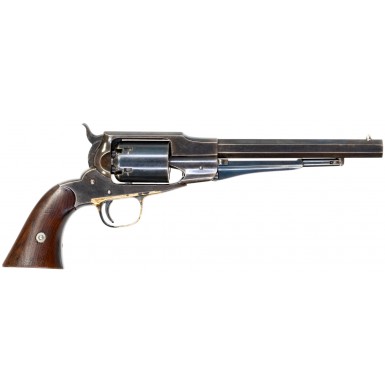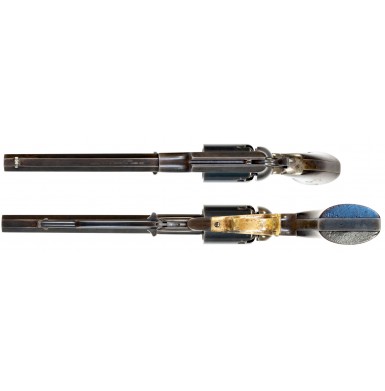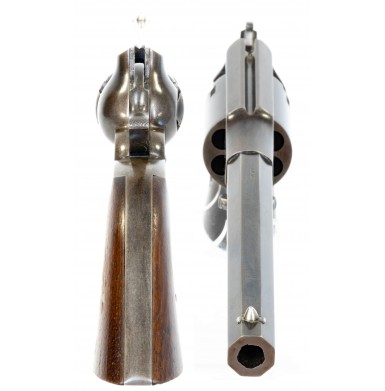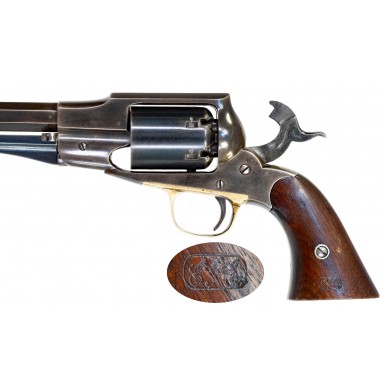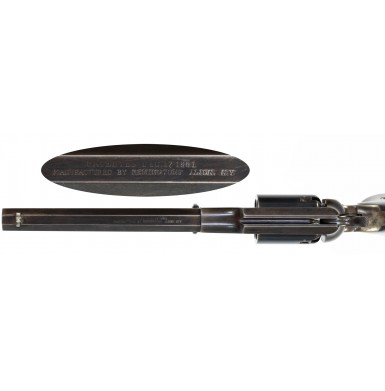Fine Transitional Beals to Elliot Martial Remington Navy Revolver
- Product Code: FHG-3517-SOLD
- Availability: Out Of Stock
-
$2,495.00
In 1856, with the addition of Remington’s three sons to the business, the firm officially became E. Remington & Sons. The following year, their first revolver was ready for sale, the Remington-Beals Pocket revolver. This was the invention of Remington employee Fordyce Beals. Beals had been instrumental in the production of the Jenks carbine contract, and had actually been acquired from Ames, as had the machinery, as part of the negotiated arrangement between Remington and Ames. Beals’ design was a compact, single action, .31 caliber revolver that bore a resemblance to the “Walking Beam” revolver then in production by Whitney. This should come as no surprise as the Whitney revolver was based upon Beals’ 1854 patent which evaded Colt’s protection of his pistol’s mechanism. In 1856, Beals patented the features that were salient to his new Remington revolver, and in 1858 patented the cylinder pin and loading lever system that would define the profile of all the large-frame Remington handguns through the 1880s.
Beals’ 1858 patent (#21,478) was granted on September 14th of that year and covered the winged cylinder arbor pin that secured the cylinder to the frame. The arbor pin was retained by the loading lever located under the barrel and could be withdrawn from the frame only when the lever was lowered. Thus, began the evolution of the second most used US marital revolver of the American Civil War. The first guns were produced in .36 caliber and production started to roll off the assembly line during late 1860 or early 1861. The .36 caliber “Navy” revolver was followed by a .44 caliber “Army” variant soon thereafter. By the time Beals-Navy production ended in 1862, some 15,000 of the handguns had been produced, while only about 2,000 of the larger “Army” revolvers had been manufactured, before the William Elliot “improved” Model 1861 pattern Remington revolvers (also known to collectors as the “Old Model”) superseded the Beals model.
The Beals Navy Revolver was Remington’s first large frame, martial handgun to make it into production. The earlier Beals “Army”, a scaled-up version of the pocket model, was only produced as a prototype and it is believed that less than 10 were actually manufactured. The Beals Navy was a single action, 6-shot revolver with a nominally 7 ½” octagonal barrel that was screwed into the solid frame. While most references list the barrel length as 7 ½” some of the earlier examples measure closer to 7 3/8” in length. The guns were blued throughout, with brass triggerguards and a color casehardened hammer. The gun had two-piece smooth walnut grips, secured by a screw that passed through German silver escutcheons and a cone shaped German silver front sight was dovetailed into the top of the barrel near the muzzle. There were a number of differences between the Beals model and the later production “Old Model” 1861 and the subsequent “New Model” 1863 revolvers. The most obvious differences were the “high spur” hammer and the fact that frame concealed the barrel threads at the rear of the barrel. Shortly after the “Old Model” 1861 went into production, these features were eliminated. A relief cut in the frame revealing the threads at the barrel’s end was added to reduce the possibility of lock up due to fowling and a lower spur hammer was adopted eventually to reduce the potential for the breakage of this part. The system of retaining the cylinder arbor pin via the loading lever evolved as well. While the Beals revolver required the lever to be lowered to withdraw the pin, the Model 1861 included a relief cut in the top of the loading lever that allowed the pin to be pulled forward with the lever in its upright and locked position. This was considered an improvement, and the feature was patented by Remington employee William Elliot, who would be responsible for a number of successful Remington firearms designs. This “improvement” proved to be a failure in the field, as the arbor pin could slide forward in the relief cut under recoil. When this happened, the cylinder often locked up, making the revolver useless. An eventual “fix” was developed for this potentially fatal flaw. A filister-head screw was added to the inside of the loading lever that acted as a stop against the cylinder pin. This meant that the lever again had to be lowered to remove the pin, essentially returning the design to the original Beals concept.
The Beals models did not have safety notches on the rear of the cylinder that would allow the hammer to be safely dropped and locked between cylinder chambers. This feature was added to the Model 1861 and 1863 revolvers. Other minor evolutions occurred as well, including making the loading lever slightly larger and more robust. As the Beals was the first of the large frame martial Remington revolvers it underwent some changes and improvements during its production.
The US government had been relatively pleased with the original Beals Navy design and had obtained some 11,249 of the nominally 15,000 Beals Navy revolvers produced. The purchases had been a combination of direct contract with Remington, combined with open market purchases of some 7,250 revolvers that would not pass through a government inspection process. In June of 1862, the Ordnance Department let a contract for 5,000 additional “Navy” caliber revolvers to Remington. The guns delivered under this contract appear to be a combination of late Remington Beals Navy revolvers and the new Model 1861 Elliot revolvers. The serial numbering of the Model 1861 revolvers continued from the Beals Navy revolvers, with the numbers mixing somewhat randomly at the end of Beals production and the beginning of Model 1861 production. This can probably be attributed to the using up of older parts on hand, thus the existence of “transitional” Remington Navy revolvers. Between August and December of 1862, a total of 5,001 .36 Remington Revolvers were delivered under this contract. Due to reports of issues in the field with the new Elliot Model 1861 revolvers, modifications and improvements occurred during the production of the “Old Model” Navy revolvers, which eventually morphed into the “New Model” or Model 1863 revolvers. No additional .36 caliber revolvers would be purchased from Remington by the Ordnance Department after the final December 1862 deliveries, but a huge number of the New Model 1863 Army revolvers would be acquired between 1863 and 1865.
Offered here is a FINE condition example of a Remington Elliot “Old Model” 1861 Navy Revolver. The gun is an earlier production Model 1861 Navy that is essentially a transitional gun that retains the earlier Beals concealed barrel thread frame, the tall spur hammer designs and has no safety notches on the rear of the cylinder. In fact, the only traditional “Elliot” features on the gun are the relieved loading lever that allows the cylinder pin to be removed without lowering it, and the “Elliot” barrel markings instead of the Beals’ patent barrel markings. The revolver does not incorporate the design modification of the filister head screw to retain the cylinder arbor pin in the top of the loading lever, which means the pin could still be withdrawn without lowering the lever. The revolver is serial numbered 15310. The serial number is present on the frame under the left grip, under the barrel (concealed by the loading lever) and written in pencil inside both of the grips. The cylinder of this revolver is not serial numbered. Serial numbers are not regularly encountered on the rear of later production Remington revolver cylinders, but on the earliest guns they are fairly common. This transitional gun appears to be in a range when the cylinders were becoming more likely to be unnumbered. As noted, the gun does not have the later production safety notches on the rear face of the cylinder that would certainly be expected on a gun with the screw modified loading lever.
The 7 3/8” octagonal barrel of the revolver is roll marked in two lines on the top flat:
PATENTED . DEC. 17 1861
MANUFACTURED BY REMINGTONS’ ILION, NY
The first line refers to Elliott’s patent for the loading lever that allowed the cylinder pin to be removed without lowering the lever, an improvement that was really a fatal flaw! Both lines of the barrel marking are crisp and deep. Apparently, the lower die was still fresh as this time as many of the guns in the latter part of the 15,XXX range have a crisp and clear upper line and a worn and weak lower line. The lower die also appears to have been replaced sometime around the 16,XXX serial number range as the guns in that range typically have crisp lower line as well. The revolver is martially sub-inspected throughout with the letter W on the upper reverse rear of the frame, on the reverse of the barrel where is meets the frame and on the upper rear edge of the reverse frame between the top of the grip and the hammer screw. A truly excellent, script CGC acceptance cartouche is present on the left grip with the right grip unmarked. This is the mark of arsenal sub-inspector Charles G. Curtis. While it was common for a sub-inspector and a final inspector to stamp their cartouches on contract arms, with the sub-inspector on the right and the final inspector on the left, many Remington revolvers appear to have only received a single cartouche.
As noted, the revolver remains in FINE condition and has a very pleasing appearance that makes the gun appear to retain more of original finish than it really does. The revolver is extremely crisp throughout with sharp edges and clear markings. The gun retains about 30%+ of its original blued finish overall, with the cylinder and loading lever retaining the most finish, followed by the barrel, and the frame showing the most loss. The sides of the frame and much of the barrel appear to have lost most of their finish due to flaking and thinning due to wear, with the additional loss along the high edges and contact points, in particular the backstrap, due to handling and use. Most of the sharp edges have a silvery appearance due to wear and loss. The metal where the finish has flaked and worn has a mostly smooth light plum patina with bluish and brown undertones. Under strong light is clear that there are only wispy traces of bright blue left on the gun, particularly on the frame and barrel, and that the patina has blended in such a way as to make the gun appear to have tremendously more original finish than it really does. The metal is almost entirely smooth with only some very lightly scattered minute flecks of surface oxidation here and there, with a couple of slightly larger patches of minor freckled roughness on the right upper angled barrel flat near the muzzle. The hammer has a muted, smoky bluish gray patina with some dull mottling that hints at its original color casehardening. The brass triggerguard has a mellow, medium golden patina with darker mottled surface oxidation and discoloration that is quite attractive.
The bore of the revolver is in VERY FINE condition. It is mostly mirror bright and retains extremely crisp rifling throughout. The bore shows some very lightly scattered areas of surface oxidation, some scattered pinpricking, and some frosting in the grooves. The revolver remains in mechanically excellent condition and functions correctly in every way. The revolver times, indexes and locks up exactly as it should. The loading lever functions smoothly and locks into place securely. The cones (nipples) all appear to be original and although they show some light wear but remain fairly crisp and fully functional. The original German silver cone front sight is in place on the top of the barrel near the muzzle and remains fully height and is not worn down. The two-piece smooth, oil finished, walnut grips remain in FINE condition as well. They are solid and are free of any breaks, cracks, or repairs. The grips are very crisp but do show some very small areas of chipped loss along the lower sharp edges, as well as a few dings and surface mars from carry and use. As noted, the left grip bears an excellent cartouche and both grips are pencil numbered to the gun on interiors.
Overall, this is a really wonderful example of an early production and delivery, Remington Elliot 1861 “Old Model” Navy Revolver. The gun retains some nice strong traces of its original finish, particularly on the cylinder, and is very crisp throughout. The gun is fully sub-inspected and has a really wonderful cartouche. The gun does not have the later production loading lever modification with the added screw and would be typical of the last of the .36 caliber Remington revolvers delivered to the government in this form. For a gun that was delivered no later than the fall of 1862, it remains in really stunning condition and would be a fantastic addition to any collection of Civil War period martial revolvers, particularly a collection that centers on Remington revolvers.
SOLD
Tags: Fine, Transitional, Beals, to, Elliot, Martial, Remington, Navy, Revolver


